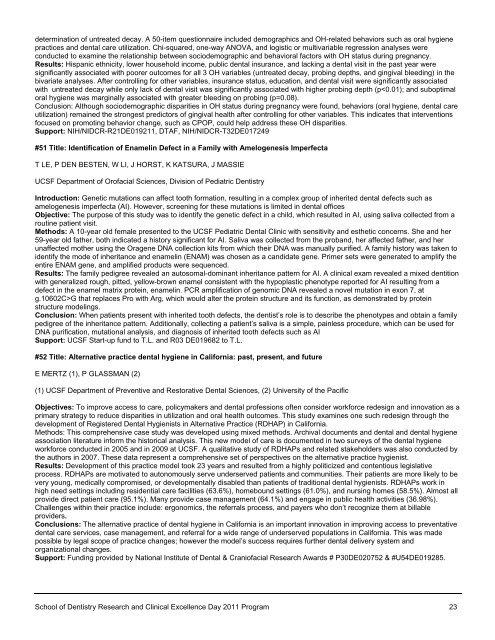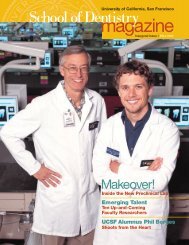Acknowledgements - UCSF School of Dentistry - University of ...
Acknowledgements - UCSF School of Dentistry - University of ...
Acknowledgements - UCSF School of Dentistry - University of ...
Create successful ePaper yourself
Turn your PDF publications into a flip-book with our unique Google optimized e-Paper software.
determination <strong>of</strong> untreated decay. A 50-item questionnaire included demographics and OH-related behaviors such as oral hygiene<br />
practices and dental care utilization. Chi-squared, one-way ANOVA, and logistic or multivariable regression analyses were<br />
conducted to examine the relationship between sociodemographic and behavioral factors with OH status during pregnancy.<br />
Results: Hispanic ethnicity, lower household income, public dental insurance, and lacking a dental visit in the past year were<br />
significantly associated with poorer outcomes for all 3 OH variables (untreated decay, probing depths, and gingival bleeding) in the<br />
bivariate analyses. After controlling for other variables, insurance status, education, and dental visit were significantly associated<br />
with untreated decay while only lack <strong>of</strong> dental visit was significantly associated with higher probing depth (pG that replaces Pro with Arg, which would alter the protein structure and its function, as demonstrated by protein<br />
structure modelings.<br />
Conclusion: When patients present with inherited tooth defects, the dentist’s role is to describe the phenotypes and obtain a family<br />
pedigree <strong>of</strong> the inheritance pattern. Additionally, collecting a patient’s saliva is a simple, painless procedure, which can be used for<br />
DNA purification, mutational analysis, and diagnosis <strong>of</strong> inherited tooth defects such as AI<br />
Support: <strong>UCSF</strong> Start-up fund to T.L. and R03 DE019682 to T.L.<br />
#52 Title: Alternative practice dental hygiene in California: past, present, and future<br />
E MERTZ (1), P GLASSMAN (2)<br />
(1) <strong>UCSF</strong> Department <strong>of</strong> Preventive and Restorative Dental Sciences, (2) <strong>University</strong> <strong>of</strong> the Pacific<br />
Objectives: To improve access to care, policymakers and dental pr<strong>of</strong>essions <strong>of</strong>ten consider workforce redesign and innovation as a<br />
primary strategy to reduce disparities in utilization and oral health outcomes. This study examines one such redesign through the<br />
development <strong>of</strong> Registered Dental Hygienists in Alternative Practice (RDHAP) in California.<br />
Methods: This comprehensive case study was developed using mixed methods. Archival documents and dental and dental hygiene<br />
association literature inform the historical analysis. This new model <strong>of</strong> care is documented in two surveys <strong>of</strong> the dental hygiene<br />
workforce conducted in 2005 and in 2009 at <strong>UCSF</strong>. A qualitative study <strong>of</strong> RDHAPs and related stakeholders was also conducted by<br />
the authors in 2007. These data represent a comprehensive set <strong>of</strong> perspectives on the alternative practice hygienist.<br />
Results: Development <strong>of</strong> this practice model took 23 years and resulted from a highly politicized and contentious legislative<br />
process. RDHAPs are motivated to autonomously serve underserved patients and communities. Their patients are more likely to be<br />
very young, medically compromised, or developmentally disabled than patients <strong>of</strong> traditional dental hygienists. RDHAPs work in<br />
high need settings including residential care facilities (63.6%), homebound settings (61.0%), and nursing homes (58.5%). Almost all<br />
provide direct patient care (95.1%). Many provide case management (64.1%) and engage in public health activities (36.98%).<br />
Challenges within their practice include: ergonomics, the referrals process, and payers who don’t recognize them at billable<br />
providers.<br />
Conclusions: The alternative practice <strong>of</strong> dental hygiene in California is an important innovation in improving access to preventative<br />
dental care services, case management, and referral for a wide range <strong>of</strong> underserved populations in California. This was made<br />
possible by legal scope <strong>of</strong> practice changes; however the model’s success requires further dental delivery system and<br />
organizational changes.<br />
Support: Funding provided by National Institute <strong>of</strong> Dental & Crani<strong>of</strong>acial Research Awards # P30DE020752 & #U54DE019285.<br />
<strong>School</strong> <strong>of</strong> <strong>Dentistry</strong> Research and Clinical Excellence Day 2011 Program 23




